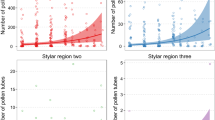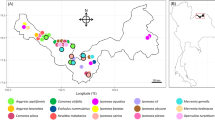Abstract
Quantifying the importance of pollinators for reproductive success of plants is a central question in reproductive biology. However, the literature contains a profusion of terms and sometimes conflicting definitions. This inconsistency is a barrier to broad comparisons and conceptual advances in different fields. In recent decades, some widely disseminated studies have proposed recommendations to foster greater standardization. Nevertheless, the literature continues with little uniformity, and terms such as “efficacy,” “efficiency,” and “effectiveness” of pollinators are still used inconsistently. Previous studies concerning conceptual and terminological uniformity provided a series of particular terms related to specific metrics and/or strict definitions for these widely used terms. I here propose comprehensive verbal definitions for the terms that have historically been used by most specialists. Pollinator performance in achieving reproductive success is defined here as its effectiveness, which is, broadly, given by the product of two components: pollinator efficacy and intensity of visitation. In some approaches, a third component – pollinator efficiency – is important for estimates of its effectiveness. The definitions suggested here apply to different variables, parameters, and procedures for study, and may refer to either individuals or populations of a pollinator species, or to functional groups of pollinators. This terminology can be applied widely, as it is not constrained by the scope, approach or scale of a study. A basic terminology with simple definitions may facilitate consistent use of these terms by specialists, particularly among younger investigators, thus surmounting the first barrier to future proposals for conceptual and methodological unification at larger scales.
Similar content being viewed by others
References
Aigner PA (2001) Optimality modeling and fitness trade-offs: When should plants become pollinator specialists? Oikos 95:177–184
Aizen MA, Morales CL, Morales JM (2008) Invasive mutualists erode native pollination webs. PLoS Biol 6:e31
Arroyo J, Dafni A (1995) Variation in habitat, season, flower traits, and pollinators in dimorphic Narcissus tazetta L. (Amaryllidaceae) in Israel. New Phytol 129:135–145
Avila RS Jr, Freitas L (2011) Frequency of visits and efficiency of pollination by diurnal and nocturnal lepidopterans for the dioecious tree Randia itatiaiae (Rubiaceae). Aust J Bot 59:176–184
Borrell BJ (2007) Scaling of nectar foraging in orchid bees. Am Nat 169:569–580
Brunet J (2009) Pollinators of the Rocky Mountain Columbine: temporal variation, functional groups and associations with floral traits. Ann Bot 103:1567–1578
Campbell DR (1989) Measurements of selection in a hermaphroditic plant: variation in male and female pollination success. Evolution 43:318–334
Canto-Aguilar MA, Parra-Tabla V (2000) Importance of conserving alternative pollinators: assessing the pollination efficiency of the squash bee, Peponapis limitaris in Cucurbita moschata (Cucurbitaceae). J Insect Conserv 4:203–210
Case MA, Bradford ZR (2009) Enhancing the trap of lady’s slippers: a new technique for discovering pollinators yields new data from Cypripedium parviflorum (Orchidaceae). Bot J Linn Soc 160:1–10
Conner JK, Davis R, Rush S (1995) The effect of wild radish floral morphology on pollination efficiency by four taxa of pollinators. Oecologia 104:234–245
Cunningham SJ (2001) An introduction to economic evaluation of health care. J Orthod 28:246–250
Dafni A, Kevan PG, Husband BC (2005) Practical pollination biology. Enviroquest, Ontario
Endress PK (1994) Diversity and evolutionary biology of tropical flowers. Cambridge University Press, Cambridge
Engel EC, Irwin RE (2003) Linking pollinator visitation rate and pollen receipt. Am J Bot 90:1612–1618
Faegri K, van der Pijl L (1979) The principles of pollination ecology, 3rd edn. Pergamon Press, Oxford
Fenster CB, Armbruster S, Wilson P, Dudash MR, Thomson JD (2004) Pollination syndromes and floral specialization. Annu Rev Ecol Evol Syst 35:375–403
Fishbein M, Venable DL (1996) Diversity and temporal change in the effective pollinators of Asclepias tuberosa. Ecology 77:1061–1073
Freitas L, Sazima M (2006) Pollination biology in a tropical high-altitude grassland in Brazil: interactions at the community level. Ann Mo Bot Gard 93:465–516
Galen C, Stanton ML (1989) Bumble bee pollination and floral morphology: factors influencing pollen dispersal in the alpine sky pilot, Polemonium viscosum (Polemoniaceae). Am J Bot 76:419–426
Gómez JM, Perfectti F, Bosch J, Camacho JPM (2009) A geographic selection mosaic in a generalized plant–pollinator–herbivore system. Ecol Monogr 79:245–263
Gowda V, Kress WJ (2013) A geographic mosaic of plant–pollinator interactions in the Eastern Caribbean Islands. Biotropica 45:224–235
Harder LD, Thomson JD (1989) Evolutionary options for maximizing pollen dispersal of animal-pollinated plants. Am Nat 133:323–344
Hargreaves AL, Harder LD, Steven JD (2012) Floral traits mediate the vulnerability of aloes to pollen theft and inefficient pollination by bees. Ann Bot 109:761–772
Herrera CM (1987) Components of pollinator “quality”: comparative analysis of a diverse insect assemblage. Oikos 50:79–90
Herrera CM (1988) Variation in mutualisms: the spatio-temporal mosaic of an insect pollinator assemblage. Biol J Linn Soc 35:95–125
Herrera CM (1989) Pollinator abundance, morphology, and flower visitation rate: analysis of the “quantity” component in a plant–pollinator system. Oecologia 80:241–248
Herrera CM (2000) Flower-to-seedling consequences of different pollination regimes in an insect-pollinated shrub. Ecology 81:15–29
Herrera CM (2005) Plant generalization on pollinators: species property or local phenomenon? Am J Bot 92:13–20
Hingston AB, McQuillan PB (2000) Are pollination syndromes useful predictors of floral visitors in Tasmania? Austral Ecol 25:600–609
Inouye DW (1980) The terminology of floral larceny. Ecology 61:1251–1253
Inouye DW, Gill DE, Dudash MR, Fenster CB (1994) A model and lexicon for pollen fate. Am J Bot 81:1517–1530
Irwin RE, Bronstein JL, Manson JS, Richardson L (2010) Nectar robbing: ecological and evolutionary perspectives. Annu Rev Ecol Evol Syst 41:271–292
Jennersten O (1984) Flower visitation and pollination efficiency of some North European butterflies. Oecologia 63:80–89
Karron JD, Marshall DL (1990) Fitness consequences of multiple paternity in wild radish, Raphanus sativus. Evolution 44:260–268
Kato E, Hiura T (1999) Fruit set in Styrax obassia (Styracaceae): the effect of light availability, display size, and local floral density. Am J Bot 86:495–501
Kearns CA, Inouye DW (1994) Techniques for pollination biologists. University Press of Colorado, Niwot
Kearns CA, Inouye D, Waser N (1998) Endangered mutualisms: the conservation of plant–pollinator interactions. Annu Rev Ecol Syst 29:83–112
Kevan PG, Baker HG (1983) Insects as flower visitors and pollinators. Annu Rev Entomol 28:407–453
Keys RN, Buchmann SL, Smith SE (1995) Pollination effectiveness and pollination efficiency of insects foraging Prosopis velutina in south-eastern Arizona. J Appl Ecol 32:519–527
Kishore K, Kalita H, Rinchen D, Lepcha B (2012) Evidence of functional specialization and pollination syndrome in Amomum subulatum Roxb. (Zingiberaceae). Curr Sci 103:193–199
Laurance WF (2009) Conserving the hottest of the hotspots. Biol Conserv 142:1137
Levin DA, Berube DE (1972) Phlox and Colias: the efficiency of a pollination system. Evolution 26:242–250
Lindsey AH (1984) Reproductive biology of Apiaceae. I. Floral visitors to Thaspium and Zizia and their importance in pollination. Am J Bot 71:375–387
Maruyama PK, Custódio LN, Oliveira PE (2012) When hummingbirds are the thieves: visitation effect on the reproduction of Neotropical snowbell Styrax ferrugineus Nees & Mart (Styracaceae). Acta Bot Bras 26:58–64
Mayer C, Adler L, Armbruster WS, Dafni A, Eardley C, Huang S-Q, Kevan PG, Ollerton J, Packer L, Ssymank A, Stout JC, Potts SG (2011) Pollination ecology in the 21st century: key questions for future research. J Pollinat Ecol 3:8–23
Memmott J (1999) The structure of a plant–pollinator food web. Ecol Lett 2:276–280
Mitchell RJ, Flanagan RJ, Brown BJ, Waser NM, Karron JD (2009) New frontiers in competition for pollination. Ann Bot 103:1403–1413
Moragues E, Traveset A (2005) Effect of Carpobrotus spp. on the pollination success of native plant species of the Balearic Islands. Biol Conserv 122:611–619
Motten AF (1986) Pollination ecology of the spring wildflower community of a temperate deciduous forest. Ecol Monogr 56:21–42
Murcia C, Feinsinger P (1996) Interspecific pollen loss by hummingbirds visiting flower mixtures: effects of floral architecture. Ecology 77:550–560
Ne’eman G, Jürgens A, Newstrom-Lloyd L, Potts SG, Dafni A (2010) A framework for comparing pollinator performance: effectiveness and efficiency. Biol Rev 85:435–451
Ollerton J, Lack A (1998) Relationships between flowering phenology, plant size and reproductive success in Lotus corniculatus (Fabaceae). Plant Ecol 139:35–47
Ollerton J, Killick A, Lamborn E, Watts S, Whiston M (2007) Multiple meanings and modes: on the many ways to be a generalist flower. Taxon 56:717–728
Ollerton J, Alarcón R, Waser NM, Price MV, Watts S, Cranmer L, Hingston A, Peter CI, Rotenberry J (2009) A global test of the pollination syndrome hypothesis. Ann Bot 103:1471–1480
Ollerton J, Winfree R, Tarrant S (2011) How many flowering plants are pollinated by animals? Oikos 120:321–326
Parker IM, Haubensak KA (2002) Comparative pollinator limitation of two non-native shrubs: Do mutualisms influence invasions? Oecologia 130:250–258
Pellmyr O, Thompson JN (1996) Sources of variation in pollinator contribution within a guild: the effects of plant and pollinator factors. Oecologia 107:595–604
Philipp M, Jakobsen RB, Nachman G (2009) A comparison of pollen-siring ability and life history between males and hermaphrodites of subdioecious Silene acaulis. Evol Ecol Res 11:787–801
Rader R, Howlett BG, Cunningham SA, Westcott DA, Edwards W (2012) Spatial and temporal variation in pollinator effectiveness: Do unmanaged insects provide consistent pollination services to mass flowering crops? J Appl Ecol 49:126–134
Sahli HF, Conner JK (2007) Visitation, effectiveness, and efficiency of 15 genera of visitors to wild radish, Raphanus raphanistrum (Brassicaceae). Am J Bot 94:203–209
Stanton M, Young HJ, Ellstrand NC, Clegg JM (1991) Consequences of floral variation for male and female reproduction in experimental populations of wild radish, Raphanus sativus L. Evolution 45:268–280
Stehmann JR, Forzza RC, Salino A, Sobral M, Costa DP, Kamino LHY (2009) Plantas da Floresta Atlântica. Jardim Botânico do Rio de Janeiro, Rio de Janeiro
Thompson JN, Cunningham BM (2002) Geographic structure and dynamics of coevolutionary selection. Nature 417:735–738
Traveset A, Richardson DM (2006) Biological invasions as disruptors of plant reproductive mutualisms. Trends Ecol Evol 21:208–216
Vázquez DP, Morris WF, Jordano P (2005) Interaction frequency as a surrogate for the total effect of animal mutualists on plants. Ecol Lett 8:1088–1094
Vázquez DP, Blüthgen N, Cagnolo L, Chacoff NP (2009) Uniting pattern and process in plant–animal mutualistic networks: a review. Ann Bot 103:1445–1457
Waser NM, Chittka L, Price MV, Williams NM, Ollerton J (1996) Generalization in pollination systems, and why it matters. Ecology 77:1043–1060
Watts S, Ovalle DH, Herrera MM, Ollerton J (2012) Pollinator effectiveness of native and non-native flower visitors to an apparently generalist Andean shrub, Duranta mandonii (Verbenaceae). Plant Species Biol 27:147–158
Wilcock C, Neiland R (2002) Pollination failure in plants: why it happens and when it matters. Trends Plant Sci 7:270–277
Young H (2002) Diurnal and nocturnal pollination of Silene alba (Caryophyllaceae). Am J Bot 89:433–440
Young HJ, Stanton ML (1990) Influences of floral variation on pollen removal and seed production in wild radish. Ecology 71:536–547
Acknowledgments
The author thanks Faperj (Jovem Cientista) and CNPq (PQ) for Research Fellowships and JW Reid for improving the English.
Author information
Authors and Affiliations
Corresponding author
Rights and permissions
About this article
Cite this article
Freitas, L. Concepts of pollinator performance: is a simple approach necessary to achieve a standardized terminology?. Braz. J. Bot 36, 3–8 (2013). https://doi.org/10.1007/s40415-013-0005-6
Received:
Accepted:
Published:
Issue Date:
DOI: https://doi.org/10.1007/s40415-013-0005-6




